#this is the closest i will ever get to a heritage speaker experience and it's truly mind-boggling
Explore tagged Tumblr posts
Text

So here’s the gist of the family vocab included in the book, I’m not going to super explain stuff/go into dialectal variation atm because I was planning to do that for a separate post. If you’re confused then survival Malayalam you need to know the words for mother, father, grandmother, grandfather, child, older brother, and older sister – these are ones that I hear a lot (well, at least the variants that my family uses which I’m not going to put here). Other Malayalees, please share what you use/distinctions you make, (especially if you’re not Nayars since that’s what my family is).
കുടുംബം /kuṭumbam/ - family
തറവാട് /taṟavātŭ/ - family house*
അമ്മ /amma/ - mother
അച്ഛൻ /acchan/ - father
മുത്തച്ഛൻ /muttacchan/ - grandfather
മുത്തശ്ശി /muttaśśi/ - grandmother
ചിറ്റപ്പൻ /ciṟṟappan/ - father's younger brother
ഭാര്യ /bhārya/ - wife
ഭര്ത്താവ് /bhartāvŭ/ - husband
കുട്ടി /kuṭṭi/ - child
ആണ്കുട്ടി /ānkuṭṭi/ - boy (lit. male child)
പെണ്കുട്ടി /peṇkuṭṭi/ - girl (lit. female child)
മകൻ /makan/ - son
മകൾ /makaḷ/ - daughter
ചേട്ടൻ /cēṭṭan/ - older brother
അനിയൻ /aniyan/ - younger brother
ചേച്ചി, ചേടത്തി /cēcci, cēṭatti/ - older sister
ചേടത്തി അമ്മ /cēṭatti amma/ - wife of oldest brother**
അമ്മാവൻ, അമ്മാമൻ /ammāvan, ammāman/ - uncle
അമ്മാവി, അമ്മായി /ammāvi, ammāyi/ - aunt
മരുമകൻ /marumakan/ - nephew or son-in-law
അളിയൻ /aḷiyan/ - brother-in-law
* - Here's Wikipedia's explanation of what this is
** - the wife of the head of the Tharavad/family house, since Nayars are matriarchal she's very important
#literally had absolutely no idea how to spell half of these#i was today years old when i learn that it wasn't mama and mai it's actually ammaama and ammayi :')#literally ammayi broke me i spent like 10 minutes watching my world suddenly fall into place#also learned like 3 days ago that THAT'S how you spell edathi#this is the closest i will ever get to a heritage speaker experience and it's truly mind-boggling#also i have never heard half of these but apparently my family is lazy and just calls everyone ettan and edathi#malayalam:general#malayalam:vocab#malayalam:reference#general:vocab#general:reference#malayalam:culture#(ish)#learn malayalam in 30 days
21 notes
·
View notes
Text
Day 111: Anfield
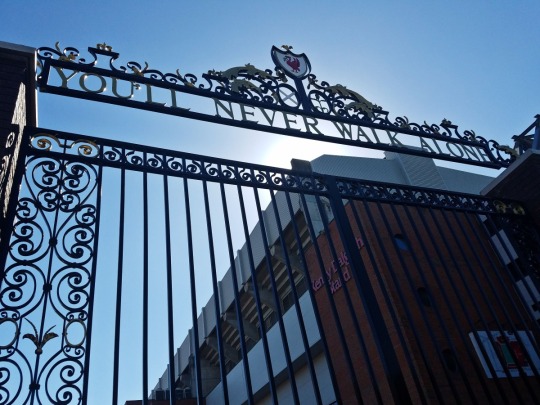
Today we visited Anfield, home turf of Liverpool Football Club and Jessica’s personal sports Mecca. We arrived early, with plenty of time to walk around the grounds and have some lunch before our scheduled tour of the stadium.

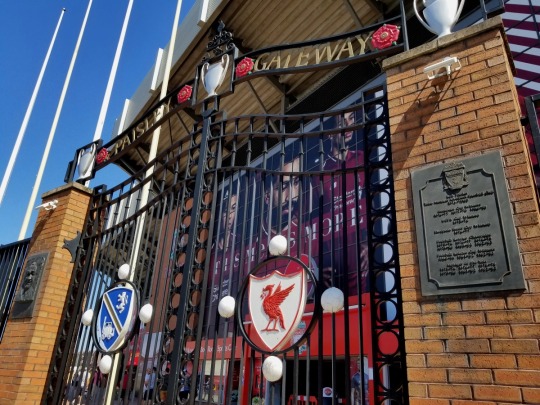
We entered through Paisley gate, named for legendary Liverpool player and manager Bob Paisley. Three trophies above the gate represent the three European Cups that LFC won under his management--a record only two other European managers have ever tied--and the crest on the left half of the gate is of Paisley's birth town, Hetton-le-Hole in northeast England.
Just inside the gate is a statue of Paisley's predecessor, the equally if not more legendary Bill Shankly. With Paisley as his assistant coach, Shankly ruthless rebuilt the team (and much of the stadium) from the ground up and dragged it from B-list ignominy into the spotlight as one of the greatest teams in all of Europe.

Shankly was famous for his relationship with the Liverpool fans. From the beginning, he insisted that the fans are the most important members of any team, and he saw their faith in him and the organization as sacred. He understood how much the team meant to the people of Liverpool, and always worked hard to show them how much they meant to him in return.
He’s also the one who picked You’ll Never Walk Alone to be the team’s anthem. It was a spur of the moment decision, but it proved momentous. It remains one of the most iconic and beloved anthems in all of sports, and it has since been adopted by numerous other teams around the world, including Celtic FC in Glasgow, Borrusia Dortmund in Germany, and FC Tokyo in Japan.
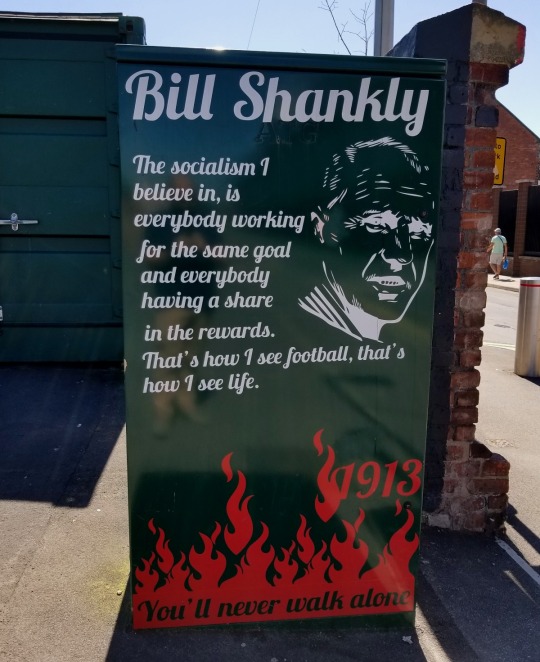
As the statue says, he made the people happy.
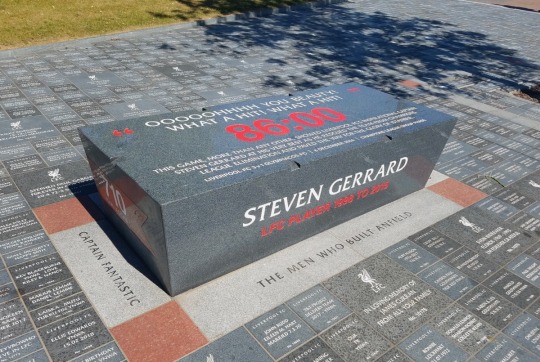
The Liverpool Football Club is rich in history and lore, and every corner of this place honors that heritage with pride, including a monument to one of the darkest chapters in the team’s--and the city’s--history.

ESPN has an excellent "30 for 30" special on the Hillsborough disaster--Jessica had me watch it when we were in York--but I'll do my best to summarize it here.
On April 15, 1989, Liverpool was playing a semi-final match against Nottingham Forest at Hillsborough Stadium in Sheffield. Shortly before kickoff, a surge of fans entered the already overcrowded pens at one end of the stadium. The pens were standing-room-only sections of the stands that were fenced off from the rest of the stands, with only a single gate for entering and leaving.
Panic ensued, and fans and police alike scrambled to tear down the fences and help people escape the crush. When the dust settled, a horrifying 94 people were found dead from crushing or asphyxiation--over a third of them children and teenagers. Over 700 others were injured, including two who would later die form their injuries.
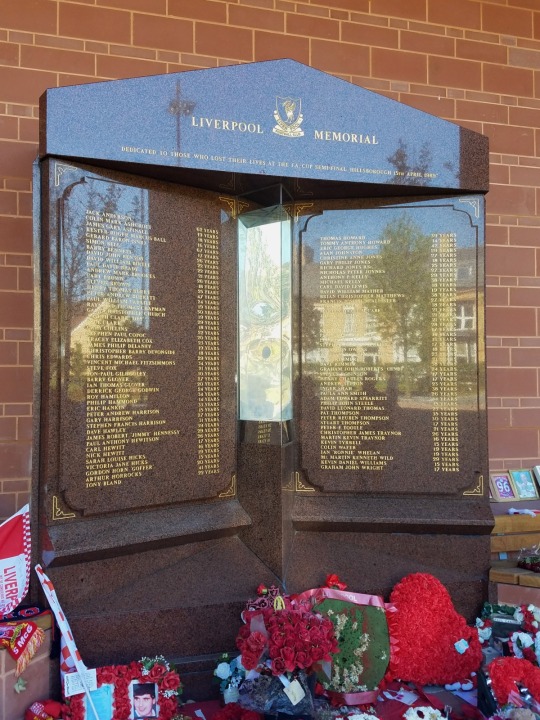
Almost immediately, the police and the Sun newspaper released the story that the disaster had been caused by Liverpool fans who had broken down the gates and recklessly stormed the pens. The rest of the country already thought of Liverpool fans as a bunch of drunken hooligans, so the story was easy to believe.
But it was a lie. Having failed to sufficiently prepare the grounds and his officers to handle the massive crowds attending the game, Police Chief Superintendent David Duckenfield--the man who officially blamed Liverpool fans for breaking down the gate--ordered himself that the gates be opened to relieve the restless crowds, having apparently forgotten that doing so would lead the throngs directly into already full pens of Liverpool supporters. Even as the bodies were being laid out on the pitch, Duckenfield was calling reporters and debriefing his lieutenants to ensure that only the “correct” officer statements made it into the official record.
False reports were leaked to the press, including absurd claims that Liverpool fans robbed the bodies of the dead, urinated on police officers, and attacked medics trying to resuscitate the victims. For years, Hillsborough survivors and the victims’ families were not only unconsoled but actively villainized as scum.

The Sun is still firmly boycotted throughout the city, and anti-Sun posters are still proudly displayed on walls and taxis.
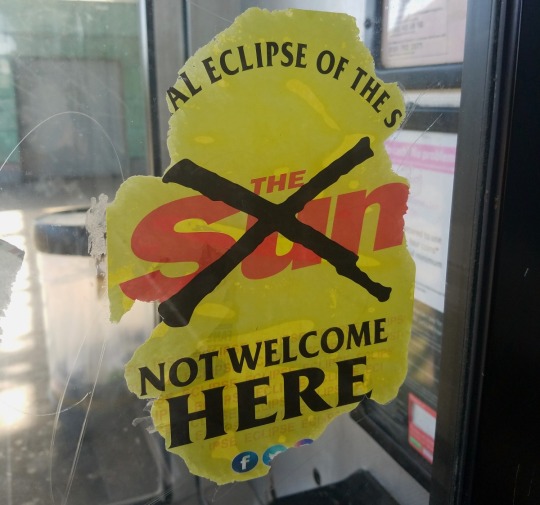
The Sun finally apologized and recanted the false stories in 2012, but for the people of Liverpool, it was far too little, far too late.
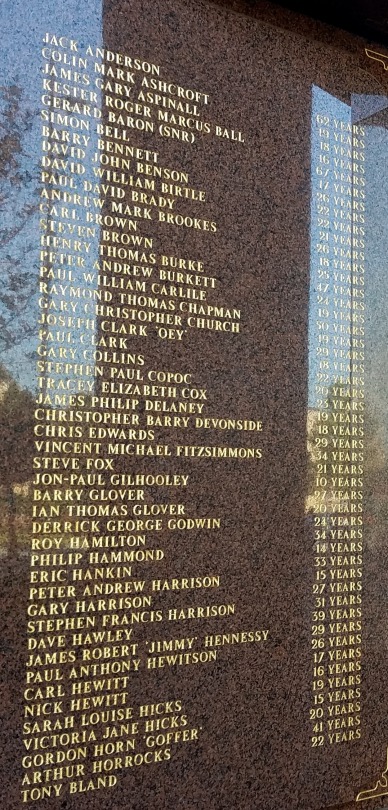
The government inquest that followed the disaster took three years to complete and ultimately ruled all the deaths to be accidental. The inquest declined to accept testimony from two practicing doctors who had been in attendance at the game and were critical of the emergency response provided. The only doctor whose testimony was admitted was that of the hosting stadium’s club doctor.
Meanwhile, an independent government investigation into the police handling of the incident thoroughly and definitively contradicted the official story, clearly exposing the cover-up and laying the blame squarely upon the police and the stadium’s design flaws. The report led to major safety improvements in stadiums across England, but no one was held accountable for the 96 dead Liverpool fans.
Years later, in 1997, the Labor party won control of parliament from the Conservatives. One of their campaign promises was to reopen the investigation into Hillsborough. The result was little more than a sham. The justice appointed to the investigation was openly hostile and derogatory of the people of Liverpool, and he declared that only new evidence would be admitted for consideration.
Since the facts of the police incompetence and cover-up were already available during previous investigations--albeit ignored--they were deemed inadmissible. Unsurprisingly, the investigation upheld that Hillsborough was an accident and no one was at fault.

Finally, after years of bitterness and failed civil suits--funded by the people of Liverpool themselves--a new independent panel was commissioned by the government in 2009 and in 2012 ruled that the Liverpool fans were in no way at fault for the disaster.
Nothing was done about it, but it was the closest thing to justice that Liverpool had gotten in over 20 years since the disaster happened.
Subsequent investigations uncovered the fact that police reports from the incident were not only curated by the brass but forged wholesale. Over a hundred officers’ statements were found to have been either edited without their consent or fabricated entirely, the originals lost to the void.
The story isn’t over. To date, not one person has yet been held accountable for in a court of law. Just this year, charges were brought against chief Duckenfield for gross negligence and manslaughter, and his trial is currently set to begin in January 2019.
Hillsborough is more than enough of a tragedy in its own right, but it’s also a case in point for the relationship between Liverpool and the rest of England. And it’s not hard to see why so many people here see themselves as Scousers first and English a distant second.
Speaking of Scousers, it was high time for something less somber: lunch.
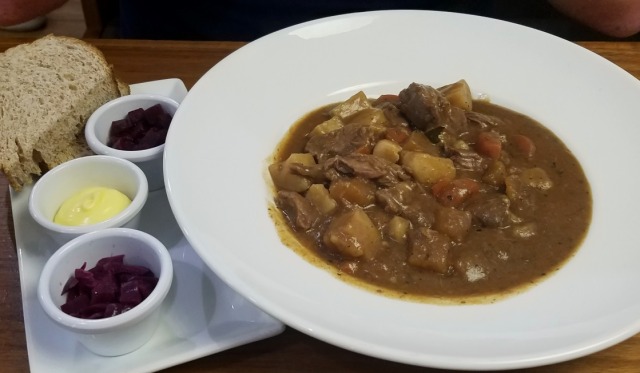
I had my first taste of scouse, a local specialty consisting of spicy meat stew with beets and red cabbage mixed in. Scouse was a popular dish among British sailors, so naturally it became popular in the major industrial port city of Liverpool. Nowadays, the dish is so strongly affiliated with the city that the people of Liverpool are called Scousers and their unique dialect (a blend of English, Irish, and Welsh) is called Scouse.
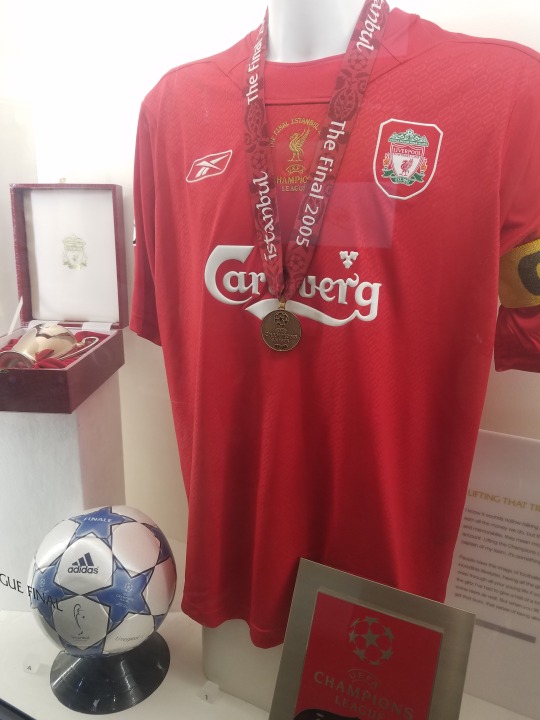
Our hearts and bellies warmed, we headed into the club museum, which was filled with stories and artifacts from the team’s founding in 1892 up through the current year. One room was entirely filled with personal memorabilia from recent team superhero Steven Gerrard, and another was occupied by the team’s five European Champions League cups--two more than the next-best team in Britain, Manchester United.
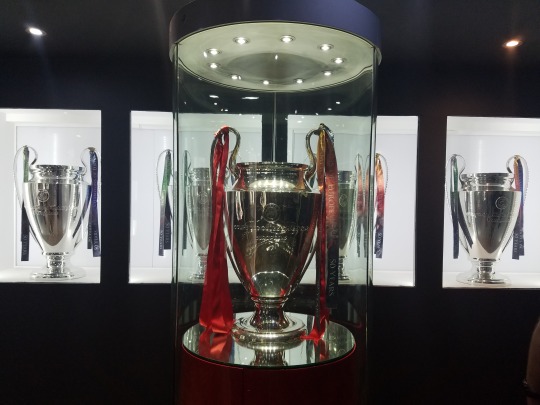
One room in the museum was made up like a section of the stands, with screens and speakers recreating the experience of being at a game while fans around you sing the team anthem, “You’ll Never Walk Alone.” Even as an outsider to football fandom, it was an incredibly moving experience.
Finally, it was time to tour the stadium itself. Jessica had visited the stadium twice before, but this tour was different. Much of the stadium had been recently renovated, and because it was the off-season, the tours were all given on self-guided tablets that we could use to scan various signs and displays for more information. Stationary guides were posted at intervals to answer questions and make sure we didn't get lost.
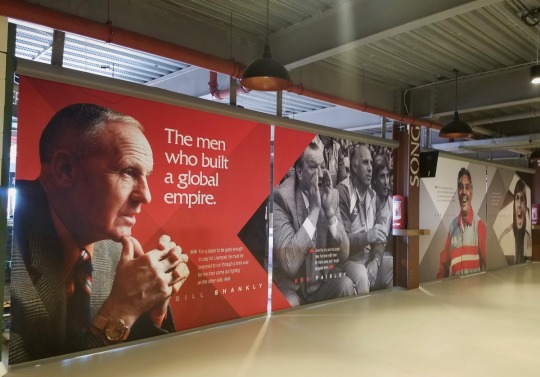
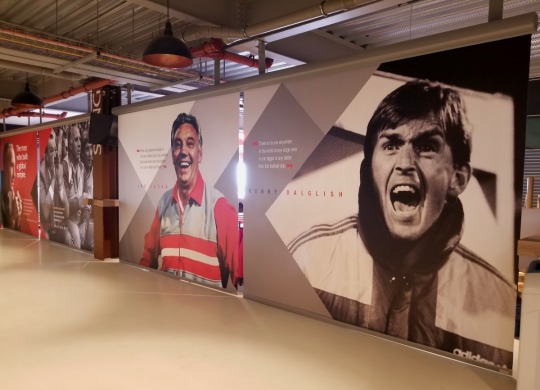
The tour starts on the top floor with a rundown of the team’s best managers and the victories the team earned under their leadership.
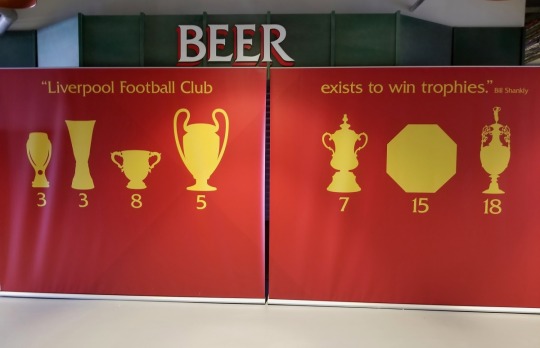
Then we turned a few corners and came out into the sunlight and glorious green pitch.
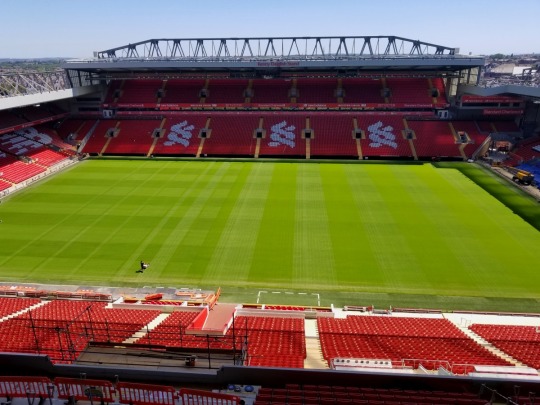

Jessica couldn’t have been happier if she was in Disneyland.
The stands on the right-hand endzone are called the Kop and where the most diehard Liverpool fans sit (if they ever do sit) during home games. The name is used for similar sections in stadiums across England and dates back to the Second Boer War of 1900. Many fields, including Anfield, had hills nearby where people could sit and watch the game. Returning soldiers compared the hills to a South African hill named Spion Kop, where a major battle took place. The hill at Anfield became known as Spion Kopp, then just Kop. Eventually, the hill was leveled to make room for larger stands, and the stands that took its place took on the name as well.
After taking it all in for a good few minutes, we continued on inside the stadium for more displays covering the history of team and stadium.

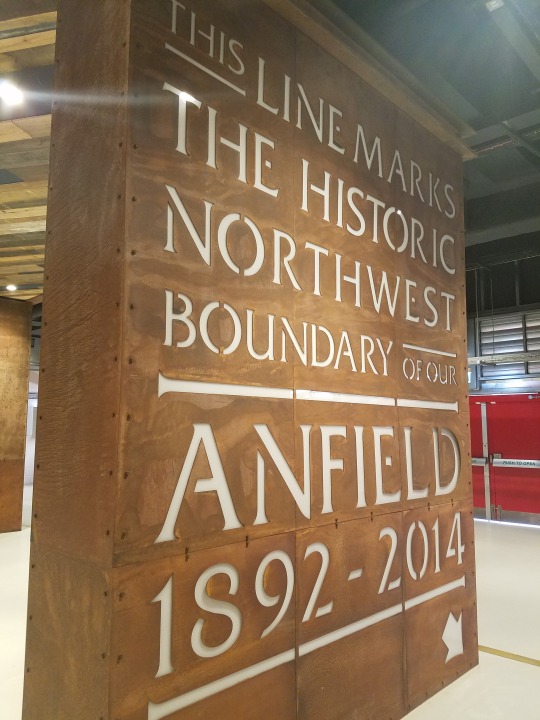
One large window looks out toward the shockingly close Goodison Park, home turf of the rival Everton Football Club.
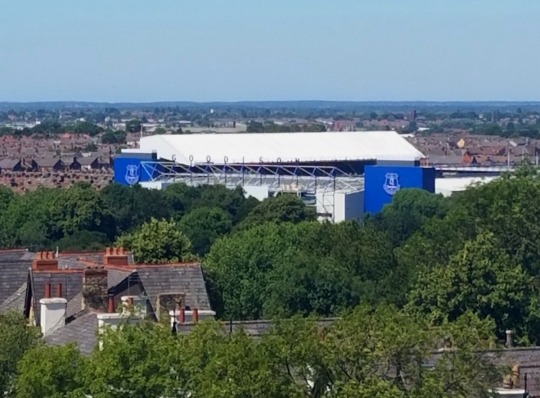
Our tablets filled us in on the history of the rivalry, but of course, Jessica already knew it all and had long since enlightened me.
Anfield was originally used by Everton, the city’s first professional football team. But as Everton became more and more successful, Anfield’s owner tried to get more and more money out of them. He also wanted to sell booze in the stadium, which the church-owned Everton FC opposed. Eventually, in 1892, Everton got fed up and built themselves their own stadium on the other side of Stanley Park, less than a mile away (and in the backyard of a church).
Left with an expensive new stadium and no team to occupy it, the owner decided to make his own team. And so Liverpool F.C. was born.
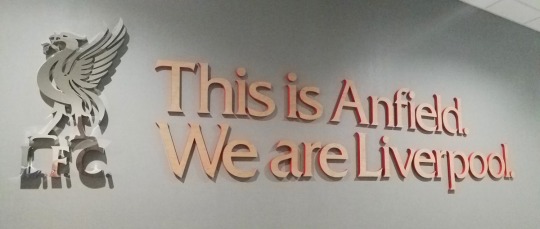
Along the way, we ended up talking with one of the stationary guides for a good while. It turned out that the first game Jessica went to at Anfield was also the first game that the guide took his grandson to. They reminisced over the great last-minute goal by Stevie G to win the game.
Somehow, though the conversation kept turning to sad things. When he asked us where we were from, we ended up talking about the terrible fires up in Napa and Sonoma the previous autumn.
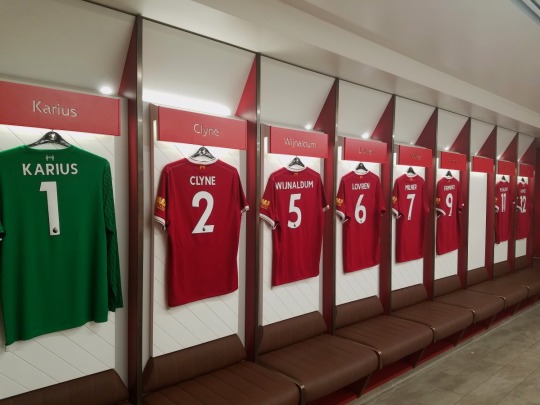
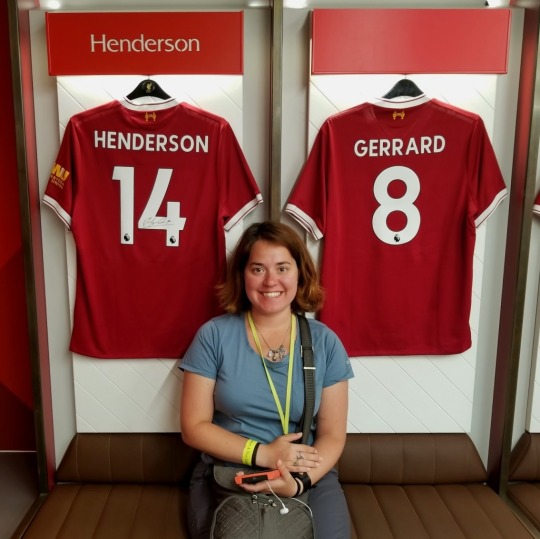
Downstairs, we saw the newly renovated dressing rooms, where Jessica was able to get her picture taken with the jerseys of some of her favorite players, including Gerrard and Mané. Using the guide tablets, we were able to scan each jersey to bring up a short interview or highlight reel about the player.
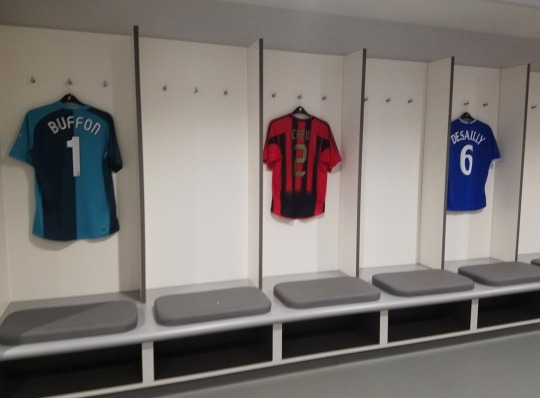
Whereas the home dressing room is warm and cushy, the visiting teams’ dressing room is drab and spartan. A selection of jerseys in the niches showed an all-star team opposing players who've visited Anfield, picked out by former Liverpool defender and local Scouser Jamie Carragher.
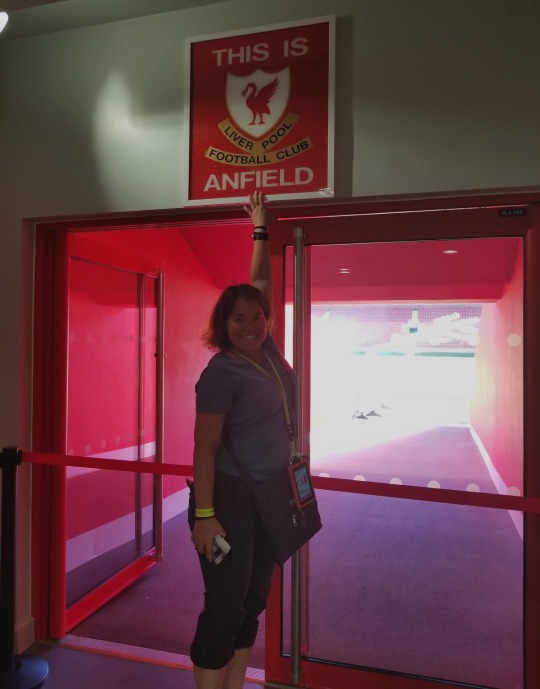
We didn't go onto the field itself--stepping onto the grass of that holy of holies is literally a crime unless you are a player or a groundskeeper--but Jessica got to touch the famous “This is Anfield” sign that the Liverpool players tap every time they go out onto the pitch.
Sadly, we didn’t get to go into the dugout or the Kop since they were both closed for maintenance.
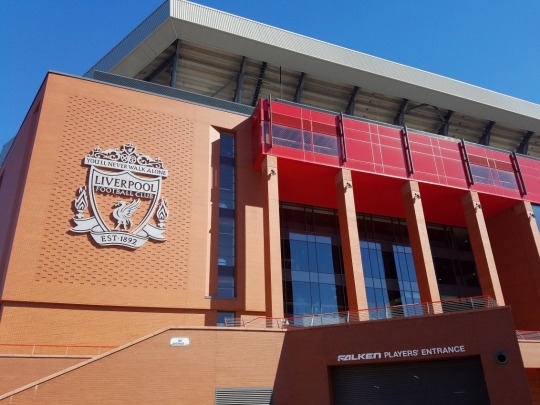
Leaving the stadium, we walked around for a bit and went into the massive new Club Shop. Jessica got some LFC stickers for her laptop, and we both got some refreshments--it had gotten surprisingly late in the day, and we’d done a lot of exploring.
While we were there, a giant-screen TV showed France knocking Argentina out of the World cup, ushering in the Round of 16.
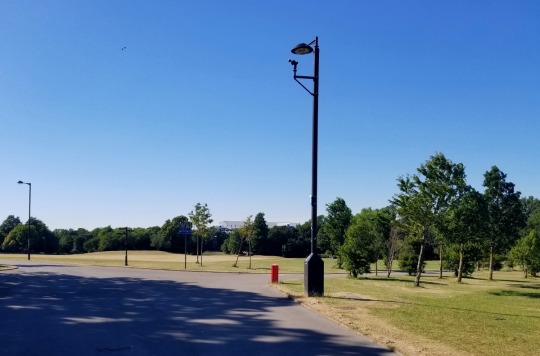
Before heading home, we took a quick stroll through Stanley Park and caught another glips of Goodison.
On the bus back to our Airbnb, we saw another sign of city’s socioeconomic standing.
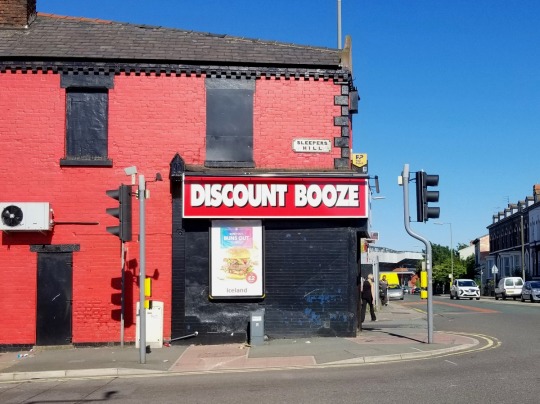
We ended up missing our stop and wound up back in central Liverpool. Getting home would take another good bit of walking--plus a major detour in search of a convenience store that actually sold decent food--but it all worked out in the end.
Back home, we watched Pirates of the Caribbean 3 and tried to ignore the obscenely loud birthday party next door that went absurdly late into the night for a kid’s party.
Next Post: The Magical Mystery Tour (and a Cathedral, too!)
Last Post: To Liverpool (With the Beatles)
1 note
·
View note
Link
There’s a personal story I’ve told many times about my experience of being African American in the great outdoors.
Back in the late 1990’s I used to live in Bellingham, Washington. One afternoon, I went with a couple of (white) friends on a hike up Mt. Baker. It was a typically overcast day in the Pacific Northwest, and as we hiked, we began to feel the chill in our bones. We stopped at a lodge along the trail with a gift shop and a roaring fire. As my friends perused souvenirs, I walked over to the fire and with my shawl wrapped around me, stood there like a content cat warming my backside. Soon I noticed an elderly white woman staring at me. As I adjusted my stance under her gaze, she jumped. I jumped. Then she walked slowly in my direction. She said, “Dear, I thought you were a beautiful Indian statue!”
To this day I can’t quite remember what I said (I believe I mumbled a thank you). I think I was just confused and astounded, because in one breath she had managed to compliment me and consider me not real.
I have many stories like this. In every circumstance, I usually wonder: Has this person ever seen a black person hiking? Has she or he ever seen a picture or heard a story of someone who looked like me in a similar setting?
While I consider myself a predominately urban person (born and bred in New York), I am no stranger to the backpack and the hiking boot. I’ve had the privilege of backpacking in many different parts of the world, trekking up to 17,000 feet. For a time, I lived in Nepal with regular access to the Himalayas. I have been serving as a member of the National Parks Advisory board for the past seven years, and before that I served on the Second Century Commission, a team of advisors who in 2009 gathered to draw out issues and priorities for the National Park Service's next 100 years. During that time, I have had the privilege to visit many national parks across the country.
A Surprising Presence, Breaking Myths
But I have always been astonished at how often white people are surprised by my presence in these spaces. For the most part, people are not unkind. I’ve been asked more than once to have my picture taken, and people want to know where I come from. Still, it never ceases to leave me with a deep-seated feeling of discomfort, of being different, and feeling decidedly out of place in these outdoor settings.
Today, part of my work as a writer, public speaker, and geography professor at the University of Kentucky is challenging all us to think differently about who has something to offer when it comes to the outdoors and environmental issues. But it started off as something personal.
Was that myth true—that “Black people don’t ______ (fill in the blank: swim, camp, ski, and so on)”? I didn’t think so. I watched my parents care for twelve acres of land that belonged to someone else and do so for nearly fifty years. My father cared for every part of that landscape: the flower gardens, the fruit trees, the lawn. My mother was especially skilled at growing tomatoes, basil, and dill in the vegetable garden. And she was always pointing out the wildlife to us—the black squirrels, the white deer, and the snapping turtles. While the estate owners visited on weekends and holidays, my family lived there 24/7. My parents couldn’t afford to take us on vacation to a national park, so that estate was where my brothers and I developed a great appreciation for nature.
Though the outdoors shaped my own childhood, I rarely saw black and other non-white people in mainstream coverage of the topic. Mainstream media and environmental organizations have been slow to consider or represent a large chunk of those who love wild places—and in light of the celebrations around the national park system this year, it’s become even clearer that we still have a lot of work to do.
If, as I have, you sorted through the historical narrative surrounding the national parks, the movies and books about the parks, the magazine and newspaper coverage of the parks—you’d come up with narratives that largely leave out the experiences of people of color.
Some might say that many of these works and organizations are about the parks, not people. But I would respond that the parks are about us. And that “us” has always been diverse, even if those in the positions to write the stories and make the policies have not.
The parks are a repository of memory—only, the different or more challenging parts of our history don’t get as much airtime in our national narrative. We’ve all heard about John Muir and President Roosevelt standing on Glacier Ridge in 1903. But at that same time, African Americans could not move freely in any space around the country because of Jim Crow; American Indians were still fighting about being forcibly removed from much of that park land; Hispanos in New Mexico were watching their access to these lands diminish as federal land agencies took over; and a diverse Asian population was experiencing a variety of challenges for simply being different on this soil.
Our Black Park History
Did you know there was an all-black Civilian Conservation Corp that was responsible for taking care of the trails at Mt. Rainier? Have you heard about Israel Lafayette Jones, who bought three islands in Key Biscayne back in the late 1800’s and whose son, Lancelot Jones, ended up resisting the overtures of developers who wanted the land and instead made a deal with the NPS? Or MaVynee Betsch, a woman who gave away all of her wealth (including her home) to environmental causes starting in the 1970s? She convinced the NPS to protect 8.2 acres of sand dunes on Amelia Island’s American Beach; her great grandfather had purchased it in the 1930’s so that black people could live on and go to the beach in Florida during Jim Crow segregation.
None of these stories are any less important simply because we might choose to universalize one piece of the parks story. That’s why so much of my studies focus on what gets left out. It’s still happening today: films like the recent National Parks Adventure feature a predominantly white cast; mainstream outdoor media (Outside included) still feature a majority of white subjects; and people of color are seriously underrepresented in environmental organizations.
When I look at the majority of environmental and outdoor media these days, I don’t see me. More specifically, I don’t see a space for me. Making that space is critical: my run-in with the woman on Mt. Baker, for example, gave us a chance to engage and have our worlds shift just a little. By seeing people who look different from us in these spaces—with their histories, memories, and their possibilities—our story about the parks, and environment in general, can more fully embrace the complexity of the human experience.
Representing All People: Making it Happen
How can we make this happen? I’m privileged to be part of the Next 100 Coalition—an ethnically and racially diverse group of civil rights, environmental justice, conservation, and community activists. We believe that in this centennial year, staff, leadership and community engagement with all our public lands agencies (National Park, Forest Service, Fish & Wildlife, Bureau of Land Management) does not reflect the growing diversity of our country. We have asked President Obama to issue a Presidential Memorandum that addresses workforce diversity, landscape scale conservation, stakeholder engagement, historical and cultural preservation, and access to public lands. We met with Christy Goldfuss, managing director of the White House Council on Environmental Quality (CEQ), to discuss our vision and strategize specific policy suggestions. And across the country, we continue to talk with the press and media, both locally and nationally, to tell our stories and make our case.
I believe that people tend to write and create what they know. You want a different story? Let’s get different people to tell it! Part of the challenge of representation is understanding who has the privilege of being part of these structures—and who does not. It’s pretty simple: More diversity at the table means more diverse experiences, knowledge, and ways of seeing the world.
Folks to Read About
There are folks like Audrey Peterman, who blogs for the Huffington Post and wrote two books with her husband, Frank, on their national parks experience. Or Marquetta Goodwine (known as Queen Quet) who, along with her community in South Carolina, was instrumental in creating the Gullah Geechee Cultural Heritage Corridor. John Francis spent 22 years walking across the U.S. to spread a message of environmental respect (and did it without talking for 17 of those years). Jhana Senxian, a Harvard-trained anthropologist, founded Sustainability Guild International in Boston to create a new model for sustainability and community engagement in the city. Jason Brown, the NFL center who walked away from millions of dollars to start a thousand acre farm in North Carolina, learned to farm on YouTube (really) and now gives away thousands of pounds of vegetables every year. How cool would it be to have the face of this black football player on a movie or television screen? Can you imagine all the kids who would be surprised and positively impacted by that image?
I hope a lot of people will go watch the movies and read the books celebrating the centennial and our national parks. I’m guessing that for many, the closest they may get to some of our grander spaces like Yosemite or the Grand Canyon is the movie theater or that book. But I also hope that there are those who will wonder why their presence in this story is not apparent; who will take this opportunity to talk about it with others; and who will not be stopped from going to experience the great outdoors wherever they live.
18 notes
·
View notes
Text
2018: A Year in Photography
New Post has been published on https://photographyguideto.com/trending/2018-a-year-in-photography/
2018: A Year in Photography
2018 was a pretty busy year for me. I set foot in 24 countries, visited a whopping 42 new UNESCO World Heritage Sites, and over 20 National Park Service Sites in the US.
On the photography front, I was named Photographer of the Year for a fourth time by the Central States chapter of the Society of American Travel Writers, won seven NATJA Awards, and was named Best Travel Photography Blog at the TBCAsia Awards in Sri Lanka.
You can also check out my year-end photo essays for 2012, 2013, 2014, 2015, 2016, and 2017.
As always, I hope you enjoy viewing them as much as I did taking them!
Image at the top of the page is of the Jungfrau Express, Switzerland.
[1] My first trip of 2018 was to New York for the New York Times Travel Show, where I was a speaker. Whenever I visit New York I try to visit National Park Service sites in the area. This year I decided to visit St. Paul’s Church, which is a Revolutionary War Era church which is located just outside the city limits of New York. It is literally about 200m away from the last subway stop in the Bronx. Very few people know about this site, including most New Yorkers. I visited with my friend Seth Kugel and we recorded an episode for his YouTube Channel “Amigo Gringo” (FYI, it’s in Portuguese).
[2] In February I visited Montenegro, one of my favorite countries in Europe, and one that I firmly believe is one of the up and coming destinations over the next few years. Visiting in February gave me a totally different perspective than most people get who visit by cruise ship during the summer. When I visited the Old City of Kotor, it was basically empty. I saw no other tourists anywhere.
[3] I was able to explore parts of Montenegro which most visitors never see. Driving up the mountains above Kotor gave me a view of the entire Bay of Kotor. You could see all the way to Herceg Novi where I stayed during my trip. If you ever visit the Bay of Kotor, I highly recommend going up the mountains surrounding the bay for the best views.
[4] In my quest to visit world heritage sites, I had to visit one of the newer site, the Stecci Medieval Tombstone Graveyards. They are located all over the Balkans, with two of them in Montenegro. Getting there was quite the adventure as everything in the north of Montenegro was covered in snow, the road there wasn’t plowed, and there were no signs. However, I found the GPS coordinates and we managed to find it in the middle of a snow-covered field!
[5] I was surpsied to find one of the most beautiful vistas I’ve seen in Europe in Montenegro. The Pavlova Strana Viewpoint is a spot which is perfectly aligned with the waters and island of Lake Skadar National Park. While it isn’t a place most people know about, it isn’t very hard to reach if you have a car.
[6] In February I traveled to Lousiana to attend my first ever Mardi Gras. Unlike most people, I was able to experience Mardi Gras in Lafayette and parts of rural Louisiana, not New Orleans. One of the highlights of the trip was attending a boucherie, which is a community festival where they butcher a pig and eat every single part of it. There was sausage, cracklings, and even headcheese. This photo was of one of the butchers who was waiting for the food to finish cooking.
[7] The Courir de Mardi Gras is the rural celebration of Mardi Gras on the actual day. It is a long parade which consists of lots of costumes, floats with porta pottys, alcohol, and occasionally chasing a chicken.
[8] Floats during the Mardi Gras parade in Lafayette are all created by “crews” who are clubs or organizations who get together to create their floats. As with the rural version of the parade, there is lots of alcohol and plastic beads.
[9] Prior to 2018 I hadn’t spent a lot of time in Louisiana. I had been there before, but this was the first opportunity I had to spend significant time in the state. In addition to the Mardi Gras festivities, I was also able to see some other sites, including canoing in Lake Martin. It is an incredibly photogenic area.
[10] In early March I went north up to Churchill, Manitoba to see the northern lights. I had been up to Churchill back in 2016 to photograph polar bears and it is one of my favorite places in Canada. I’d never pass up an opportunity to visit Churchill. Unfortunately, we didn’t have any luck with the northernlights, but we did have an amazing meal in Fort Prince of Wales, and I was able to go dog sledding again.
[11] In May I was scheduled to attend the big IPW travel show in Denver. I had some time, so I figured I’d drive there and visit some national parks along the way. One of the spots I visited was the northern section of Theodore Roosevelt National Park in North Dakota. I had been to the park before, but only the southern section which is located on Interstate 94. The northern section gets fewer visitors and in many ways has more dramatic scenery.
[12] After Denver, I headed west to visit some more parks in Colorado and Utah. One of the most surprising places was Colorado National Monument, which is just outside of Grand Junction. It easily could be upgraded to full national park status at some point in the future. I had never been in the northwestern part of Colorado before and it was interesting to see how it different it was from the rest of the state.
[13] Another surprising site was Dinosaur National Monument, which is located right on the Colorado/Utah border. There is an entire wall of rock with in-situ bones of dinosaurs which you can see. It is perhaps the best palentology site I’ve visited in the world, and I have visited several of them.
[14] I finally got to Arches National Park in Moab, Utah. Unfortunately, I wasn’t really paying attention to the calendar, and I wound up there on Memorial Day Weekend. The park was very busy and hotels in Moab were incredibly expensive. I’d love to return in the winter when the crowds are gone and there is snow on the ground.
[15] About 20 miles away from Arches is Canyonlands National Park. Even though they are in close proximity of each other, Canyonlands gets significantly fewer visitors than Arches does. Oddly enough, I found Canyonlands to be the better park. There are some dirt roads you can drive in the park, but they require a four-wheel drive vehicle and more time than I had. I’d love to return to Canyonlands to photograph the park away from the main road.
[16] Capitol Reef was the fifth and final of the Utah National Parks that I visited. It is unually busy considering that I thought it was the least interesting of the 5 Utah parks. However, it is also the closest park to Salt Lake City, which probably explains the attendence. The park has a very odd shape, and like Canyonlands, most of it can only be explored off-road.
[17] Going back into Colorado, I made a visit to Mesa Verde National Park. This was my second time in Mesa Verde and this visit really was too short. Again, because of Memorial Day, I was very lucky to get a hotel room. I think I got the last available room in Cortez just because someone else canceled.
[18] From Colorado I drove through New Mexico to Amarillo, Texas where I was speaking the Central States Chapter of the Society of American Travel Writers. The Texas Panhandle is often overlooked as a destination, which is too bad because I’ve enjoyed my trips there the last two years. Carhenge is one of the most photographed attractions in Amarillo and it is located off the interstate just west of town.
[19] On the way back home I visited more national park service sites, including one that I’ve wanted to visit for several years: Tallgrass Prairie National Preserve. I love the prairies and there isn’t much of it left anymore as most of it was plowed under.
[20] In June I was back in Louisiana, this time to New Orleans. Believe it or not, this was my first ever visit to New Orleans. I was speaking at the annual travel convention for the Public Relations Society of America. This shot was taken at the Chalmette Battlefield, which was the location of the famous Battle of New Orleans during the War of 1812.
[21] My summer trip to Europe began in Eastern Europe. I was there to travel on a trip with G Adventures through the Baltic Countries. I arrived early, however, because I wanted to visit Belarus. Belarus offers a 5-day visa on arrival for anyone who arrives at the Minks Airport. I took the very short flight from Vilnius to Minks and spent several days visiting some of the world heritage sites in Belarus. This is a photo of Mir Castle, a 15th-century construction and one of the most popular attractions in the country.
[22] My G Adventures tour of the Baltic States began in Vilnius. I found Vilnius to be the most artistic and countercultural of the 3 Baltic capitals. This street art is a good example of that attitude.
[23] Vilnius is also the location of the Republic of Uzupio, which is a ficticious country in the middle of a bohemian section of the city. The “republic” has their own constitution which consists of 38 articles which is printed on metal plates in 23 languages.
[24] Just outside of Vilnius is the town of Trakai and Trakai Castle. It is located in the middle of a lake and gets a far amount of local visitors in the summer from Vilnius. It is a beautiful area with many cafes and restaurants on the shore of the lake. The castle itself is open to the public and is worth a visit.
[25] The next stop in Lithuania was the Curonian Spit, which is a large sand spit which is in the Baltic Sea, and is shared between Lithuania and Russia. We stayed in the town on Nida which was only 2km from the Russian border. We did a 20km bike trip, which wasn’t bad but was also something I haven’t done in a long, long time. Needless to say, my butt was very sore that day.
[26] Riga really showed the differences between the Baltic countries. Even though they are often thought of as a group, they have very different liguistically and culturally. Lithuania is predominantely Catholic, for example, where as Latvia and Estonica are Protestant. Riga, being a port on the Baltic, had a much more international feel than Vilnius did.
[27] In Estonia, our first stop was on the island of Saaremaa, which is the largest island in Estonia. While Tallinn gets most of the international visitors, Saaremaa seemed to be more of a destination for locals. The isalnd was pretty laid back and we saw Kuressaare Castle and one of the best preserved impact craters in Europe.
[28] Tallinn, was probably my favorite of the Baltic capitals, even though it is also the most visited. It gets many visitors from the cruise ships which stop there, as well as from people making the short ferry trip from Helsinki. Estonia was the most Nordic of the Baltic states, which makes sense given its location.
[29] As with my trip to Belarus, I took advantage of the visa rules to finally visit Russia. You can get a 72-hour visa if you visit St. Petersburg by ship. I took the ferry from Helsinki. Overall, the experience wasn’t really great. It was cold and raining, and I barely had 6-hours in the city before I had to get back on the ferry. I couldn’t even get into the Hermitage because the lines were so long. A longer, proper trip to Russia is still on order for me at some point in the future.
[30] From Helsinki, I flew to London and took the train down to Portsmouth where I crossed the English Channel to Normandy where I traveled along the Liberation Route, following the path of the Allied forces during WWII. While I was in Normandy I visited all of the landing beaches as well as most of the museums and cemeteries of the region.
[31] Driving up from Normandy I visited the town of Bastogne, which was made famous during the Battle of the Bulge in WWII. The museum here was surprisingly good, and the collection of WWII military equipment they had was outstanding. So much of the equipment that the United States manufactured for the war was left in Europe. Much of that today is in the hands of the various WWII museums. The military equipment museum in Bastogne, located in the old military barracks, in one of the best in Europe.
[32] One of the most inspiring moments I had in 2018 was doing the Sunset March across the bridge in Nijmegen, Netherlands. The bridge was the location of action during Operation Market Garden where 48 Allied soldiers lost their lives taking a bridge across the Waal River. In 2013, a new bridge was constructed with 48 pairs of street lights which turn on at sunset to represent the 48 men who lost their lives. Since its opening, every evening at sunset a march across the bridge is lead by military veterans. Veterans from all countries are invited to take part and everyone is welcome to march with the veterans. The march itself takes about 12 minutes, not including the time requires to talk back across the bridge after it is completed.
[33] On my way to Berlin I stopped at the Bergpark Wilhelmshöhe outside of Kassel, Germany. It is a giant hillside waterworks which was built in the 18th Century. They only run the water 2 days a week (Wednesday and Sunday) in the summer and I was lucky to be there on a Wednesday. There are huge crowds which gather to see the water flow down the hill as well as the fountains and waterfalls along the way.
[34] After Germany, I began a trip to visit all of the World Heritage Sites in the Czech Republic which I hadn’t previously visited. One of the highlights was the town of Kuta Hora. Prague seems to get all of the attention in the Czech Republic, and towns like Kuta Hora are often ignored by foreign visitors. That is too bad because while Prague is great, there is a lot which the Czech Republic has to offer if you just get out of the city.
[35] Another World Heritage town in the Czech Republic which I enjoyed was Telc. The town square is what it is most famous for, but the entire area surrounding the town is captivating as well. Again, it is well known amongst Czechs, but not as much with the rest of the world.
[36] The column in Olomouc was high on my list of places to visit for one major reason: this is the smallest world hertiage site on Earth. Just as a test, I timed myself and it took me 54 seconds to walk around the column at a leislury pace. It was originally built as a thanks for surviving the black death.
[37] I ended my trip in the Czech Republic in Ostrava where I spoke at TBEX Europe. The event was held in a converted industrial facility. It was really an interesting place to hold a conference. The main stage was actually built inside and old fuel tank.
[38] From the Czech Republic I flew to Zurich where I started a trip where I visited all of the World Heritage Sites in Switzerland. The first site I visited was the Serdona Tectonic Area. High up in the Apls, it is a popualr hiking area. You can get a vantage point where you can see the entire country of Liechtenstein! During my day hiking here, my Fitbit told me I had climbed the equivalent of a 226 story building….and that is only the uphill part.
[39] I’d been to Switzerland before, but I had only visited the German-speaking areas around Zurich, Basel, and Bern. This trip I was able to explore most of the country including the Italian, French, and Romanch speaking regions. I fell in love with the Italian speaking city of Bellinzona and the entire canton of Ticino. The world heritage site was the three castles in Bellinzona, but everything in the region was amazing.
[40] Prior to this trip, the site I was looking forward to visiting the least was the watching making town of La Chaux-de-Fonds. I left Switzerland thinking that this was the most interesting world heritage site in the country. I was really unaware of the history of Swiss watching making and just how much of it was centered around this community. Every major watch manufacturer I’ve ever heard of has offices and/or a factory here. The museum of watchmaking museum in La Chaux-de-Fonds was fascinating and I could have spent several hours more there.
[41] In September I flew down to Barbados for the SATW annual convention where I was a speaker. I had been to Barbados previously, but it was a short trip and I didn’t get to see Bridgetown properly. This time I was able to do a proper tour and learn more about why Barbados was so central to British colonial efforts in the 17th and 18th Centuries.
[42] In October I drove down to Chicago for the Visit Europe Media Exchange where I met with several European destinations. I was also able to do a bit of exploring and took a boat tour on the Chicago River, something which I had never done before. In my opinion, Chicago has the best architecture in the United States, easily beating New York. I also visited the Pullman National Monument in Chicago, which is one of the newer additions to the National Park Service.
[43] I made a last minute decision to drive to St Louis rather than go directly back home. That took me through Springfield which was the home of Abraham Lincoln and the location of the other National Park Service Site in Illinois. In addition to Lincoln’s Home, I also visited his tomb, which is where is photo was taken.
[44] I hadn’t visited the St. Louis Arch in almost 20 years, so I wanted to return so I could photograph it. The arch had been closed for renovation and when it reopened, it was also renamed Gateway Arch National Park; the newest and smallest national park in the United States. The new visitor center under the arch is well done and it is a worth place to visit, even if I don’t think it should be called a national park.
[45] I was invited to speak at a blogging event in Colombo, Sri Lanka. Having never been to Sri Lanka, I jumped at the chance to go. I was able to visit the region around the central Sri Lankan city of Kandy. This is the entranct to the Temple of the Tooth, a temple which is believed to hold a tooth of the Buddha.
[46] The central region of Sri Lanka is very moutntainous, which can make getting from place to place rather time consuming. However, it also makes for beautiful landscapes. This photo was taken in the Knuckles Mountain Range, which is one the 8 World Heritage Sites in Sri Lanka.
[47] In Kandy, we visted the Royal Botanical Gardens which had an excellent collection of trees and flowers from Sri Lanka. It also had quite a few monkeys, some of which took the time to pose for the camera.
[48] Considering how far I had to come to get to Sri Lanka, I figured I might as well go to the Maldives while I was there. It is only a 90-minute flight from Colombo. I stayed at a Cinimon Hotels Resort on the island of Ellaidhoo. I was able to play with my drone, read, and relax. It was the closest thing I had to a vaction all year (traveling is not necessarily a vacation).
[49] Late November brought me to Spain. I have been to Spain many times before, but this trip took me to Extremadura, a region which is west of Madrid and north of Andalucia. It doesn’t get nearly as many visitors as other parts of Spain, but it is one of the richest regions in terms of culture, history, and food. My first stop there was the Royal Monastery of Santa Maria of Guadalupe. I took this photo of the monastery from the balcony of my hotel at night.
[50] I didn’t know much about the city of Merida before I had arrived, other than it was one of the world heritage sites in Spain. I left thinking it was one of the best sites for Roman ruins and history in the world. It is on a par with other Roman towns you can visit today such as Jerash, Ostia Antica, and Pompeii. The museum of Roman history in Merida might be the best museum of Roman artifacts I have ever visited.
[51] The town of Trujillo is not a world heritage site, but perhaps it should be. It was one of the important centers of early Spanish colonization and the home to many of the first Spanish Conquistadors.
[52] My 2018 travels ended in a place I was not expecting to visit: Saudi Arabia. I was invited to attend the inaugural Formula E race which was held in Riyadh. Saudi Arabia has been a notoriously difficult country to visit in the past because they never offered tourist visas. They have just started offering tourists visas and opening up the country to the rest of the world. We took a side trip to the north of the country to visit Madin Saleh, a site I never thought I’d actually be able to visit. It is a site built by the Nabateans, which are the same people who built Petra in Jordan.
Source
https://everything-everywhere.com/2018-a-year-in-photography/
0 notes
Text
Bound Iron: Part 2
For the second time in a day Breholf awoke with a start. The back of his head thundered in time with his heartbeat as if someone was battering a frantic retreat on the battlefield. His source of a rapid pulse was utter panic. His arms and legs were immobile and Breholf himself was held aloft in a spread eagled position. Once he came to his senses, at least as much as his torpidity would allow, he realised that he had been stripped of his skintight armourweave and left bare as the day he had been born.
A hunched over figure was in front of him tending to a task that Breholf couldn’t summarise. Though he was awake and slowly coming to a more alert state the thumping of his head had not yet abated. A groan left his lips as he jostled in the restraints which were encasing his hands and feet. A gel-like texture could be felt like cushions around the end of his limbs though it did little to relieve him of the strain at being made to hover above the ground.
The sound of Breholf’s struggles caused the figure to turn and the young Mandalorian blanched at what he saw. As if someone had taught a spider to stand, wear clothes and operate medical equipment the creature had six arms; two of which were made of silvered metal. The mechanical limbs ended in a collection of injectors, scalpels, staplers and saws. None of which seemed like a good idea to put against his skin.
“Good.” the creature chittered. “Good. You are awake. My lady will be pleased.” With six eyes of a cardinal hue it watched him. Each seemed to blink independently from one another. The stocky creature turned its face away which Breholf only noticed it to have been branded; burnt flesh and fur in the shape of a letter or sigil he did not recognise. The Mandalorian however knew what it meant. He had seen it before. The strange alien, like himself, was a slave though their roles within the household obviously differed.
With one of its organic arms the spider reached forward to press an intercom. “Duchess?” he growled into the device.
A familiar, cool and feminine voice crooned over the speaker. “Yes, Doctor Elaris?” she responded.
“Your last slave to be inspected has awoken. Forgive me if it has been too long. I did not wish to risk damaging him with a forced revival.”
There was a silence and the sound of someone ruffling on the other end of the device. “I shall be there in but a moment.” A click closed the line and ended the conversation.
Breholf decided it was time to speak out. The strangeness of this doctor’s appearance was too new, too alien for him to just ignore it. “What...what are you?” he grunted as he tackled with the words in his mouth.
Another chitter came from Elaris as he stepped closer until Breholf could feel the arachnid’s bristles against his skin. “Harch, young man. I am a Harch. And a doctor. A bloody good one I should think. But your job isn’t to ask questions. It is to kill and die at the pleasure of our mistress. I am merely there to make sure you are salvageable.”
Elaris reached for a nearby button and with a delicate digit pressed it down. The restraints around Breholf hummed forebodingly and all of a sudden he felt every muscle in his being convulse and tighten up like taut wire. He could smell something like a heavy thunderstorm had rolled through the room. After what seemed like an eternity the convulsions stopped and Breholf fell forward with a gasp following by a cry outwards.
“And you have not been given leave to question.”
“Starting with me are you, Doctor?” a shrill voice rang out.
Breholf lifted his head which felt like someone had cast lead inside of it. A haze clouded his vision until it sharpened. His eyes beheld a beautiful creature; feline in feature; lithe with a coy smile. Breholf noticed her sky-blue tunic and given that the Duchess said she’d be joining the pair in the medical bay even his addled wits came to the conclusion that this was his new owner. Beside her was a large reptilian he knew to be a Trandoshan but with his powers of observation hamstrung by the shock he had received he wasn’t able to determine if he was a slave or employee. Was there even a difference?
Soft hands cupped the Mandalorian’s face as she kept his head aloft and prevented it from slumping forward. She inhaled deeply with her nose but an inch from his face. “Young.” she said as her hands released his cranium and ran down the front of his chest. Her nails etched along his flesh and down every rise and dip of his body that was offered out to her. “Strong.”
Finally her hand came up over his left breast where his heart roared beneath the surface. There her pointed nails played over the ink that had been etched into his body. “And Mandalorian. Oh you are everything your kind stands for.”
At that Breholf realised he was right. He had indeed been targeted for his heritage. The Mandalorians were among the most feared warriors the galaxy had ever seen. Bred from birth to fight, honed into killing machines, their culture practically defied war itself. As mercenaries and bounty hunters they could turn the tide for those with enough credits to buy their loyalty; no matter how fleeting it was. If, however, they conducted their Crusades then left uncheck they would pillage, conquer and burn all they could reach.
As a lone Mandalorian he was easy prey for slavers since when surrounded by clans of armoured and heavily armed warriors it was indeed a difficult notion to take one alive.
“Tell me about him.” said Alvaria ordered Elaris, her pink glossed lips curving into a cruel grin.
Elaris inclined his head as Breholf once more managed to lift his head to watch the interaction. A defiant emerald fire blazed in his eyes as he listened intently.
“The blow to his head has not caused any lasting damage. Apart from that particular mishap your property is in fighting shape. I believe we can begin with the implantation procedure. Judging by his biogenetic data I can surmise he is at least twenty standard years of age. A perfect candidate ”
“Excellent!” the Zygerrian woman said as she clasped her hands together as if someone had told her she had won a prize. Her heels clacked with each step she took back to Breholf which was but a short distance away from the six-eyed-and-armed doctor and her reptilian aide.
The young warrior turned his head and watched Alvaria grow closer. A breath hitched as she boldly grasped at his length that hung between his toned thighs and give him a firm grip. “I forgot to mention virile. My oh my. I best keep you away from the pleasure den, shouldn’t I?” At her words or simpering expression Breholf didn’t react as he was too busy trying to think of something, anything to keep the swelling of arousal at bay. In a dubious stroke of luck it seemed it didn’t need to for her enclosed hand over his length and his balls below fiercely tightened causing his eyes to widen and a hiss of agony slid from his lips.
With her hand still in a vice-like constriction around his manhood Alvaria spoke. “I would not get the wrong idea, Mandalorian, for as beautifully crafted as you are you’ve not earned my interest. Instead think of this as a lesson. Pleasure and pain. For I will give to you the former beyond your wildest dreams; perhaps if you impress me enough even from my own body. But for now you will experience the reality of your new found situation and not even your foolish warrior pride or gods or code will stave away the paroxysm of my lash.”
She released her palm and for the first time in his time within the medical bay Breholf let out a genuine sigh of relief despite the now aching sensation between his legs. “Pain, Doctor Elaris. Pain. For this one I say we skip the anesthetics.”
A guttural laugh came from the Harch as he brought Breholf’s restraints around so he faced the floor; back pointed towards the ceiling. There was a sound of clattering and equipment being shifted. Soon the Duchess’ heels echoed away from him and soon the Mandalorian was left in the hexagonally limbed male.
Then he felt it. A cold sharp pain which made his fists ball up inside the restraints. It was like someone was running an icicle along the part of his back just before it connected to his neck. The sensation became deeper and Breholf’s eyes flew wide open along with his mouth which let out a snarling cry of protest. Something dripped from where the feeling had taken place and oozed down his skin.
The slithering continued until what was causing it became apparent. A single crimson raindrop splashed in front of him followed by another and several more. His cries became screams, tears of pain blinding him. Something was pushed into the incision at the back of his neck then sewn up again. It was quick work. Relatively speaking. Breholf soon found himself back upright this time faced with two Zygerrian guards; the feline men dressed in gear armour and carrying blaster carbines.
With a click the restraints released him and he fell onto his knees. Breholf took some time to gather his breath before attempting, successfully, to get to his feet though his legs were shaking. Wordlessly the guards pointed to a set of clothes. If they could be called that. A long blue tunic and simple leather boots.
“Inside your neck.” the doctor began. “Is a microdite charge. You know what microdite is, yes?”
“A small power explosive related to detonite. I get the implications.” Breholf replied glumly.
It took Breholf some time given the pain he was under but finally what little modesty he managed to scrape together had been secured before he looked to the guards.
“What now?” he asked, tilting his head to one side.
“You follow.” the closest guard ordered. “You stray, we kill. You stop, we kill. Human understands?”
Not about to get into the debate of his genetic background Breholf just raised his hands as the galactic sign language for understanding.
“Good. Human not stupid. Like most. You follow.”
Without a word of protest he followed the guards to his next destination.
0 notes